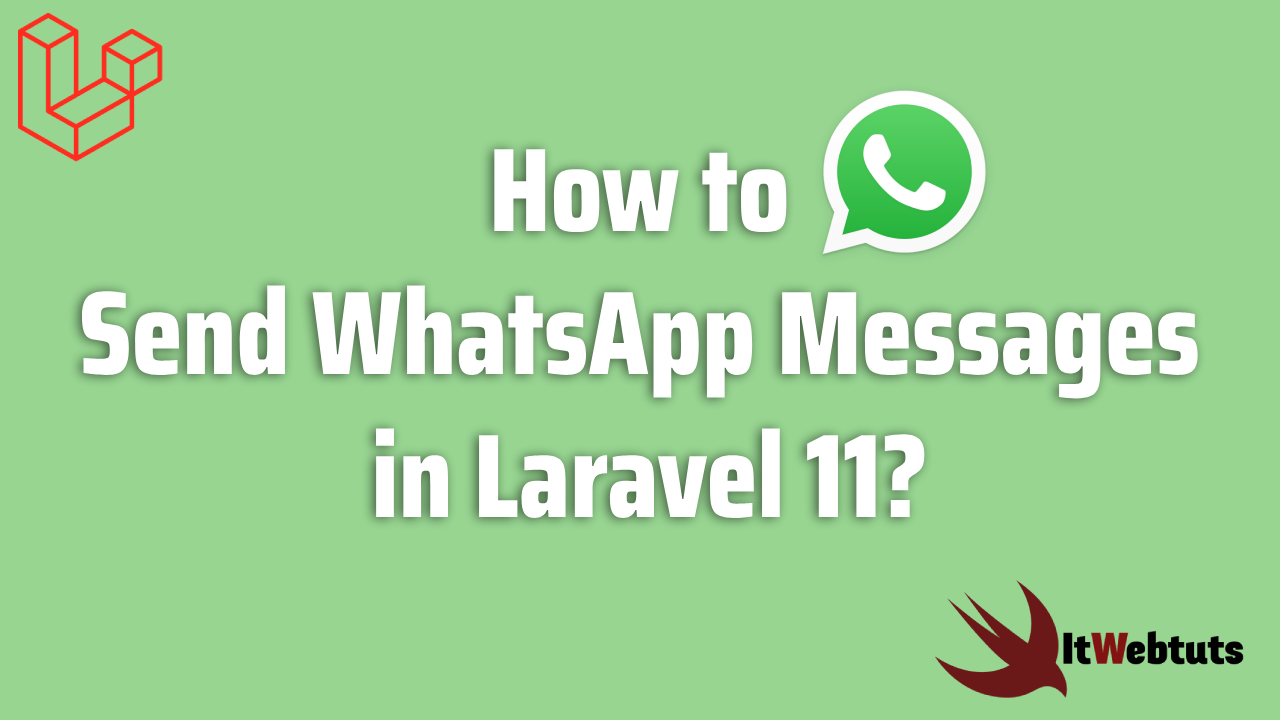Hi, Guys
In this blog, I'll demonstrate how to send WhatsApp messages using the Twilio API in a Laravel 11 application.
Twilio is a cloud communications platform that provides a flexible API, allowing developers to integrate voice, messaging, and video capabilities into their applications. Renowned for its simplicity and scalability, Twilio supports multiple programming languages. Its API facilitates seamless incorporation of features like sending SMS, making voice calls, and implementing two-factor authentication. Twilio's services enable businesses to improve customer engagement and communication, offering a powerful solution for creating innovative and interactive applications across various industries.
In this example, we will use third-party package "twilio/sdk" for send whatsapp message to users. Twilio provides a WhatsApp API that allows you to send messages and media to WhatsApp users programmatically. here, we will create simple form with phone number and message box. then we will send WhatsApp message to given number. so, let's follow the following steps to done this example.
Step for Laravel WhatsApp API IntegrationStep 1: Install Laravel 11
Step 2: Set up a Twilio Account
Step 3: Install twilio/sdk Package
Step 4: Create Route
Step 5: Create Controller
Step 6: Create Blade File
Run Laravel Applet's follow bellow steps:
Step 1: Install Laravel 11This step is not required; however, if you have not created the Laravel app, then you may go ahead and execute the below command:
composer create-project laravel/laravel example-appStep 2: Set up a Twilio Account
First you need to create and add phone number. then you can easily get account SID, Token and Number.
Create Account from here: www.twilio.com.
Next add Twilio Phone Number
Next you can get account SID, Token and Number and add on .env file as like bellow:
.envTWILIO_SID=your_twilio_account_sid TWILIO_AUTH_TOKEN=your_twilio_auth_token TWILIO_WHATSAPP_NUMBER=your_twilio_whatsapp_numberStep 3: Install twilio/sdk Package
In this step, we need to install twilio/sdk composer package to use twilio api. so let's run bellow command:
composer require twilio/sdkStep 4: Create Route
now we will create one route for calling our example, so let's add new route to web.php file as bellow:
routes/web.php
<?php
use Illuminate\Support\Facades\Route;
use App\Http\Controllers\WhatsAppController;
/*
|--------------------------------------------------------------------------
| Web Routes
|--------------------------------------------------------------------------
|
| Here is where you can register web routes for your application. These
| routes are loaded by the RouteServiceProvider within a group which
| contains the "web" middleware group. Now create something great!
|
*/
Route::get('whatsapp', [WhatsAppController::class, 'index']);
Route::post('whatsapp', [WhatsAppController::class, 'store'])->name('whatsapp.post');
Step 5: Create Controller
in this step, we will create WhatsAppController and write send sms logic, so let's add new route to web.php file as bellow:
app/Http/Controllers/WhatsAppController.php
<?php
namespace App\Http\Controllers;
use Illuminate\Http\Request;
use Twilio\Rest\Client;
use Exception;
class WhatsAppController extends Controller
{
/**
* Write code on Method
*
* @return response()
*/
public function index()
{
return view('whatsapp');
}
/**
* Write code on Method
*
* @return response()
*/
public function store(Request $request)
{
$twilioSid = env('TWILIO_SID');
$twilioToken = env('TWILIO_AUTH_TOKEN');
$twilioWhatsAppNumber = env('TWILIO_WHATSAPP_NUMBER');
$recipientNumber = $request->phone;
$message = $request->message;
try {
$twilio = new Client($twilioSid, $twilioToken);
$twilio->messages->create(
$recipientNumber,
[
"from" => "whatsapp:+". $twilioWhatsAppNumber,
"body" => $message,
]
);
return back()->with(['success' => 'WhatsApp message sent successfully!']);
} catch (Exception $e) {
return back()->with(['error' => $e->getMessage()]);
}
}
}
Step 6: Create Blade File
Here, we will create "whatsapp.blade.php" file with following code:
resources/views/whatsapp.blade.php
<!DOCTYPE html>
<html>
<head>
<title>How to Send WhatsApp Messages in Laravel 11? - Itwebtuts.com</title>
<meta charset="utf-8">
<meta http-equiv="X-UA-Compatible" content="IE=edge">
<meta name="viewport" content="width=device-width, initial-scale=1">
<link href="https://cdn.jsdelivr.net/npm/bootstrap@5.0.2/dist/css/bootstrap.min.css" rel="stylesheet">
</head>
<body>
<div class="container">
<div class="row">
<div class="col-md-9">
<div class="card">
<div class="card-header">
<h2>How to Send WhatsApp Messages in Laravel 11? - Itwebtuts.com</h2>
</div>
<div class="card-body">
<form method="POST" action="{{ route('whatsapp.post') }}">
{{ csrf_field() }}
@if ($message = Session::get('success'))
<div class="alert alert-success alert-block">
<strong>{{ $message }}</strong>
</div>
@endif
@if ($message = Session::get('error'))
<div class="alert alert-danger alert-block">
<strong>{{ $message }}</strong>
</div>
@endif
<div class="mb-3">
<label class="form-label" for="inputName">Phone:</label>
<input
type="text"
name="phone"
id="inputName"
class="form-control @error('phone') is-invalid @enderror"
placeholder="Phone Number">
@error('phone')
<span class="text-danger">{{ $message }}</span>
@enderror
</div>
<div class="mb-3">
<label class="form-label" for="inputName">Message:</label>
<textarea
name="message"
id="inputName"
class="form-control @error('message') is-invalid @enderror"
placeholder="Enter Message"></textarea>
@error('message')
<span class="text-danger">{{ $message }}</span>
@enderror
</div>
<div class="mb-3">
<button class="btn btn-success btn-submit">Send Message</button>
</div>
</form>
</div>
</div>
</div>
</div>
</div>
</body>
</html>
Run Laravel App:
All the required steps have been done, now you have to type the given below command and hit enter to run the Laravel app:
php artisan serve
Now, Go to your web browser, type the given URL and view the app output:
http://localhost:8000/whatsappOutput:
Now you can run and check.
I hope it can help you...




